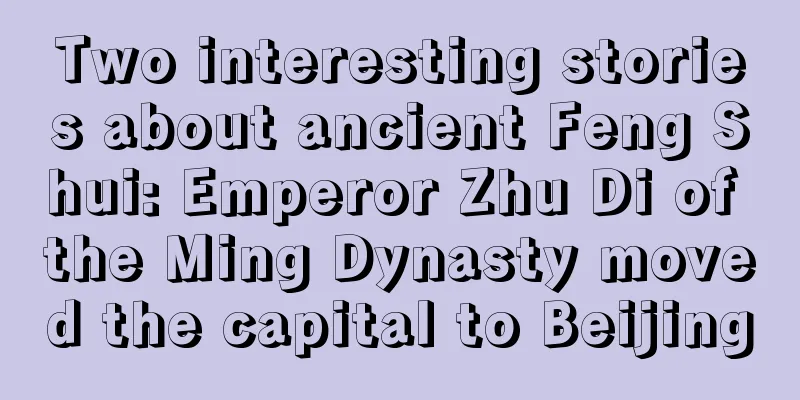Two interesting stories about ancient Feng Shui: Emperor Zhu Di of the Ming Dynasty moved the capital to Beijing

Introduction: When we were young, we liked to listen to the stories about the past told by the elderly. Some were magical, some were weird, some were fun, and some were mysterious. There are many interesting stories in Feng Shui stories. In this issue of Feng Shui stories, we will talk about why Emperor Chengzu Zhu Di moved the capital to Beijing and what kind of Feng Shui layout the Zhuge Bagua Village in Zhejiang has. Let’s find out together! Let’s take a look at this Feng Shui story that is popular among the people.Why did Emperor Zhu Di of the Ming Dynasty move the capital to Beijing?Feng Shui has always been considered the art of emperors. Emperors who built tombs or capitals always longed to get a good site. Emperors also considered the correct movement of the stars when establishing their capitals or founding their countries. There is a saying about the "Three Enclosures" namely Ziweiyuan, Taiweiyuan and Tianshiyuan. Ziweiyuan is the first of the three palaces of stars in the sky, symbolizing the residence of the emperor. Taiweiyuan symbolizes the three dukes, six ministries and nine ministers. Tianshiyuan symbolizes the territories of the twelve feudal states. Among these three palaces, the defect of any one of them represents some kind of ominous effect.The present-day Nanjing was once praised by Emperor Zhuge Liang as "Mount Zhong is like a dragon, Mount Shitou is like a tiger, and the Purple Palace is reflected in its walls. This is the residence of emperors." Yang Rong, Grand Secretary of the Ming Wenyuan Pavilion, believed that "the mountains and rivers in the world are majestic and magnificent, with a broad structure, nine stars arching together, and ten thousand stars reflecting each other to form a brilliant splendor. No one can be better than Nanjing as a capital." Precisely because of Nanjing's topography, many people have built its capital there throughout history. When Zhu Yuanzhang started his army at the end of the Yuan Dynasty, his adviser Feng Guoyong suggested: "Jinling is the capital of the emperor, so we should capture it first as our foundation." After Zhu Yuanzhang conquered the world, he established his capital in Nanjing and ordered his military advisor Liu Bowen to plan and build an imperial palace there. Liu Bowen was ordered to survey an auspicious site. He came to Zhongshan, walked around and measured carefully, carefully selected the best location for the palace, buried wooden stakes as marks, and then returned to the palace to report to Zhu Yuanzhang. Zhu Yuanzhang was very happy after hearing this, and told Empress Gao about Liu Bowen's selection of the site for building the palace. Empress Gao said, "Your Majesty is the Son of Heaven, and the whole world belongs to you. Why do you have to listen to Liu Bowen about choosing a palace?" Zhu Yuanzhang thought what Empress Gao said made sense, so he went up to Zhongshan Mountain overnight and secretly moved the wooden stakes that Liu Bowen had used to locate the palace. The next morning, Zhu Yuanzhang ordered Liu Bowen to accompany him to take a look at the selected auspicious place, so they came to Zhongshan again. When Liu Bowen saw that the wooden stakes he had buried had been moved, he understood what was going on, but he did not dare to move them by force. He said, "This place is certainly a good place, but future generations will inevitably fight over and worry about moving the capital." Zhu Yuanzhang ignored him. After Zhu Yuanzhang's death, Ming Chengzu Zhu Di indeed seized the throne of Emperor Jianwen and moved the capital to Beijing. Beijing has been known as the "Capital of Emperors" since it was established as the capital in the Yuan Dynasty. During the Jin and Yuan Dynasties, Kublai Khan, the founder of the Yuan Dynasty, received advice from a knowledgeable man named Ji Tulu, who told him that Beijing was a good place to build a capital because it is "a land of Youyan, with a magnificent situation. It controls the Yangtze River and Huai River in the south and connects to the desert in the north. The emperor is in the center and receives worship from all directions." It should be named after the "Yan" in "Youyan" so that it can conquer the world and establish a foundation for all ages. After Kublai Khan ascended the throne, he established his capital in Dayan and renamed it Dadu. Kublai Khan never forgot the contribution of Jitu Lu and often said: "The reason why I can rule the world is because of Jitu Lu's contribution." One can imagine how great the influence of Feng Shui was at that time. After Emperor Chengzu Zhu Di of the Ming Dynasty ousted Emperor Jianwen, a group of his aides wrote a petition to persuade him to make Beijing the capital: "Beijing is the place where Your Majesty was born. It is backed by Juyong Mountain in the north, bordered by Taihang Mountains in the west, connected to mountains and seas in the east, and overlooks the Central Plains. It has thousands of miles of fertile fields and mountains and rivers. It is enough to control the world and make it an eternal capital." Zhu Di believed his advisers and moved the capital to Beijing. What is the Feng Shui layout of Zhuge Bagua Village in Zhejiang?The general rule of the formation of ancient Chinese villages is that they were built according to clan rules and feng shui. However, it is probably rare to find a village like Zhuge Village in Lanxi, Zhejiang, where surnames and homelands are pushed to the extreme of a culture and become an everyday interpretation of morality and philosophy.In Zhuge Village, everything retains the simple folk customs, ancient buildings, primitive farming, and simple lifestyle. The most amazing thing about Zhuge Village is the village feng shui layout, which is unique in China - the Nine Palaces and Eight Diagrams layout. Zhuge Bagua Village was built by Zhuge Dasi, the 27th generation grandson of Zhuge Liang, in the middle and late Yuan Dynasty. It has a history of more than 600 years. Despite the passage of time and the changes in personnel, the overall structure has not changed significantly so far. It can be regarded as a great wonder in the history of ancient Chinese architecture. Its profound connotation is amazing. Zhuge Village is located in the northwest, with mountains behind it and facing the flowing water. It embodies the "momentum of heaven and earth" pursued by the Situation Sect. In addition, Zhuge Village is surrounded by eight small hills, which seem to be connected but not connected, and the eight directions shaped like the Bagua become the outer Bagua. There are tall buildings in the village, with houses of different heights and arranged in an orderly manner; the alleys are connected in all directions. The bell pond is located in the center of the village, resembling the Yin-Yang diagram of Tai Chi. Eight alleys radiate outward, forming an inner Bagua. There are hundreds of ancient buildings from Ming and Qing dynasties in the village, with carved beams and painted buildings, in various shapes and forms and with beautiful styles. All these show that the founder of the village was good at choosing the terrain, combining the surrounding natural environment with the houses and alleys to form a double Bagua, which fully reflects Zhuge Dasi's extraordinary Feng Shui art and meticulous conception. During the Song and Yuan dynasties, wars were frequent. Zhuge Dasi gave full consideration to defense issues when designing the village layout. The terrain of Zhuge Village is complex, and the layout of houses and alleys is ever-changing, with maze characteristics. This nine-square and eight-diagram layout fully reflects the defensive purpose. During the Anti-Japanese War, the Japanese invaders passed by Gaolonggang Road without discovering this prosperous village. During the Northern Expedition, the National Revolutionary Army and the warlord Sun Chuanfang fought fiercely for three days near Zhuge Village, but the village remained safe and sound. There are thousands of buildings in the village, facing each other and back to back, with alleys crisscrossing each other, seemingly connected but actually disconnected, seemingly open but actually closed; it is hard to predict what is real and what is fake. Strangers who rashly enter the village often find it difficult to get in or out, and thieves who come here often surrender. Summary: The above article content is two interesting stories about ancient Feng Shui compiled by the editor. You can learn about them and increase your knowledge of Feng Shui. |
<<: Feng Shui Story: How did the Feng Shui layout of the Shanxi Merchants’ Courtyard come about?
Recommend
Are there any good days for getting a marriage certificate or holding a wedding in the seventh lunar month of 2017?
Introduction: Getting a marriage certificate is a ...
Is the fourth day of July 2020 a good day to travel? Proverbs about the End of Heat
Is the fourth solar term on July 14, 2020, the Yea...
Analysis of the fate of a girl born on the eighth day of the eighth lunar month in 2020. Is the girl’s fate good?
A girl’s fortune is also related to the time of he...
What is the fate of a boy born on the ninth day of the ninth month of the lunar calendar? Gain fame and fortune?
Introduction: The birth of each child injects new ...
What date is October 18th of the lunar calendar in 2019? Is this a good day?
Sometimes we need to know the Gregorian calendar ...
Query the position of the God of Happiness on the 25th day of the fifth lunar month in 2018
Want to know more about the days and lucky and un...
Is it a good idea to pick up a new car on March 23rd of the lunar calendar in 2018?
In March, all things come back to life, willows a...
Is it a good idea to set up the bed on the 29th day of the first lunar month in 2022? What issues should be paid attention to when setting up the bed?
The first month is the Yin month, which is the mon...
Is the eighth day of the sixth lunar month in 2019 an auspicious day? What is the hexagram for today?
Introduction: Different days unfold in different w...
Is it possible to travel on July 19th of the lunar calendar in 2022? Is this an auspicious day?
Is it suitable to travel on July 19th of the lunar...
When is the Spring Equinox in 2020? What should I pay attention to?
After the Waking of Insects, all things come back ...
What zodiac sign will a child born on August 16, 2017 have a good personality?
Introduction: When a baby is born, there will be a...
Is May 22nd of the lunar calendar 2018 a suitable day to sign a contract?
In traditional numerology, timing is very importan...
Is the third day of the tenth lunar month in 2018 an auspicious day? Are the omens good on this day?
Introduction: In our country’s tradition, major ev...
Is August 29, 2020 suitable for praying? What should we pay attention to in the eighth month of the lunar calendar?
Introduction: It is also necessary to choose an au...









